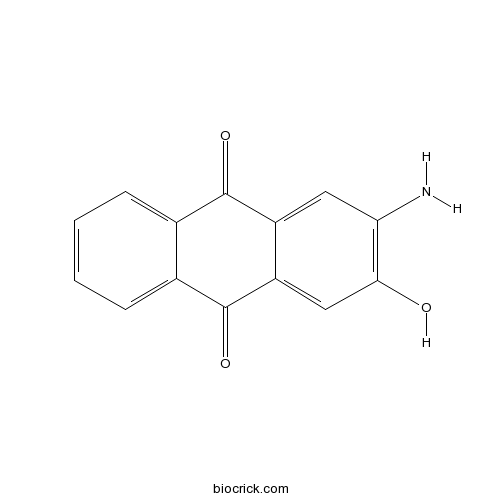2-Amino-3-hydroxyanthraquinoneCAS# 117-77-1 |

Quality Control & MSDS
3D structure
Package In Stock
Number of papers citing our products

| Cas No. | 117-77-1 | SDF | Download SDF |
| PubChem ID | 67029 | Appearance | Powder |
| Formula | C14H9NO3 | M.Wt | 239 |
| Type of Compound | N/A | Storage | Desiccate at -20°C |
| Solubility | Soluble in Chloroform,Dichloromethane,Ethyl Acetate,DMSO,Acetone,etc. | ||
| Chemical Name | 2-amino-3-hydroxyanthracene-9,10-dione | ||
| SMILES | C1=CC=C2C(=C1)C(=O)C3=CC(=C(C=C3C2=O)O)N | ||
| Standard InChIKey | CNWWMJSRHGXXAX-UHFFFAOYSA-N | ||
| Standard InChI | InChI=1S/C14H9NO3/c15-11-5-9-10(6-12(11)16)14(18)8-4-2-1-3-7(8)13(9)17/h1-6,16H,15H2 | ||
| General tips | For obtaining a higher solubility , please warm the tube at 37 ℃ and shake it in the ultrasonic bath for a while.Stock solution can be stored below -20℃ for several months. We recommend that you prepare and use the solution on the same day. However, if the test schedule requires, the stock solutions can be prepared in advance, and the stock solution must be sealed and stored below -20℃. In general, the stock solution can be kept for several months. Before use, we recommend that you leave the vial at room temperature for at least an hour before opening it. |
||
| About Packaging | 1. The packaging of the product may be reversed during transportation, cause the high purity compounds to adhere to the neck or cap of the vial.Take the vail out of its packaging and shake gently until the compounds fall to the bottom of the vial. 2. For liquid products, please centrifuge at 500xg to gather the liquid to the bottom of the vial. 3. Try to avoid loss or contamination during the experiment. |
||
| Shipping Condition | Packaging according to customer requirements(5mg, 10mg, 20mg and more). Ship via FedEx, DHL, UPS, EMS or other couriers with RT, or blue ice upon request. | ||

2-Amino-3-hydroxyanthraquinone Dilution Calculator

2-Amino-3-hydroxyanthraquinone Molarity Calculator
| 1 mg | 5 mg | 10 mg | 20 mg | 25 mg | |
| 1 mM | 4.1841 mL | 20.9205 mL | 41.841 mL | 83.682 mL | 104.6025 mL |
| 5 mM | 0.8368 mL | 4.1841 mL | 8.3682 mL | 16.7364 mL | 20.9205 mL |
| 10 mM | 0.4184 mL | 2.0921 mL | 4.1841 mL | 8.3682 mL | 10.4603 mL |
| 50 mM | 0.0837 mL | 0.4184 mL | 0.8368 mL | 1.6736 mL | 2.0921 mL |
| 100 mM | 0.0418 mL | 0.2092 mL | 0.4184 mL | 0.8368 mL | 1.046 mL |
| * Note: If you are in the process of experiment, it's necessary to make the dilution ratios of the samples. The dilution data above is only for reference. Normally, it's can get a better solubility within lower of Concentrations. | |||||

Calcutta University

University of Minnesota

University of Maryland School of Medicine

University of Illinois at Chicago

The Ohio State University

University of Zurich

Harvard University

Colorado State University

Auburn University

Yale University

Worcester Polytechnic Institute

Washington State University

Stanford University

University of Leipzig

Universidade da Beira Interior

The Institute of Cancer Research

Heidelberg University

University of Amsterdam

University of Auckland

TsingHua University

The University of Michigan

Miami University

DRURY University

Jilin University

Fudan University

Wuhan University

Sun Yat-sen University

Universite de Paris

Deemed University

Auckland University

The University of Tokyo

Korea University
- Quercetin
Catalog No.:BCN6049
CAS No.:117-39-5
- Dantron
Catalog No.:BCN6048
CAS No.:117-10-2
- Rubiadin
Catalog No.:BCN6047
CAS No.:117-02-2
- Sculponeatic acid
Catalog No.:BCN6046
CAS No.:1169806-02-3
- Sculponeatin O
Catalog No.:BCN6045
CAS No.:1169806-00-1
- Sculponeatin N
Catalog No.:BCN6044
CAS No.:1169805-98-4
- INDY
Catalog No.:BCC6349
CAS No.:1169755-45-6
- XL413 hydrochloride
Catalog No.:BCC4039
CAS No.:1169562-71-3
- XL413
Catalog No.:BCC4241
CAS No.:1169558-38-6
- Monohydroxyisoaflavinine
Catalog No.:BCN7284
CAS No.:116865-09-9
- 20-Hydroxyaflavinine
Catalog No.:BCN7283
CAS No.:116865-08-8
- Fmoc-D-Ser-OH
Catalog No.:BCC3547
CAS No.:116861-26-8
- 2-Anthraquinonecarboxylic acid
Catalog No.:BCN3451
CAS No.:117-78-2
- Bis(2-ethylhexyl) phthalate
Catalog No.:BCN6054
CAS No.:117-81-7
- Boc-Asp(Ofm)-OH
Catalog No.:BCC3366
CAS No.:117014-32-1
- Anwuweizonic acid
Catalog No.:BCN3633
CAS No.:117020-59-4
- Licopyranocoumarin
Catalog No.:BCN7900
CAS No.:117038-80-9
- 3'-Methoxypuerarin
Catalog No.:BCN2900
CAS No.:117047-07-1
- Wulignan A1
Catalog No.:BCN5808
CAS No.:117047-76-4
- Combretastatin A4
Catalog No.:BCC7089
CAS No.:117048-59-6
- 3'-Hydroxypuerarin
Catalog No.:BCN2816
CAS No.:117060-54-5
- A 967079
Catalog No.:BCC7967
CAS No.:1170613-55-4
- Scutebarbatine C
Catalog No.:BCN2382
CAS No.:910099-75-1
- Fmoc-Thr(tBu)-OPfp
Catalog No.:BCC3553
CAS No.:117088-31-0
Microbial Synthesis of Non-Natural Anthraquinone Glucosides Displaying Superior Antiproliferative Properties.[Pubmed:30154376]
Molecules. 2018 Aug 28;23(9). pii: molecules23092171.
Anthraquinones, naturally occurring bioactive compounds, have been reported to exhibit various biological activities, including anti-inflammatory, antiviral, antimicrobial, and anticancer effects. In this study, we biotransformed three selected anthraquinones into their novel O-glucoside derivatives, expressing a versatile glycosyltransferase (YjiC) from Bacillus licheniformis DSM 13 in Escherichia coli. Anthraflavic acid, alizarin, and 2-Amino-3-hydroxyanthraquinone were exogenously fed to recombinant E. coli as substrate for biotransformation. The products anthraflavic acid-O-glucoside, alizarin 2-O-beta-d-glucoside, and 2-amino-3-O-glucosyl anthraquinone produced in the culture broths were characterized by various chromatographic and spectroscopic analyses. The comparative anti-proliferative assay against various cancer cells (gastric cancer-AGS, uterine cervical cancer-HeLa, and liver cancer-HepG2) were remarkable, since the synthesized glucoside compounds showed more than 60% of cell growth inhibition at concentrations ranging from ~50 muM to 100 muM. Importantly, one of the synthesized glucoside derivatives, alizarin 2-O-glucoside inhibited more than 90% of cell growth in all the cancer cell lines tested.


